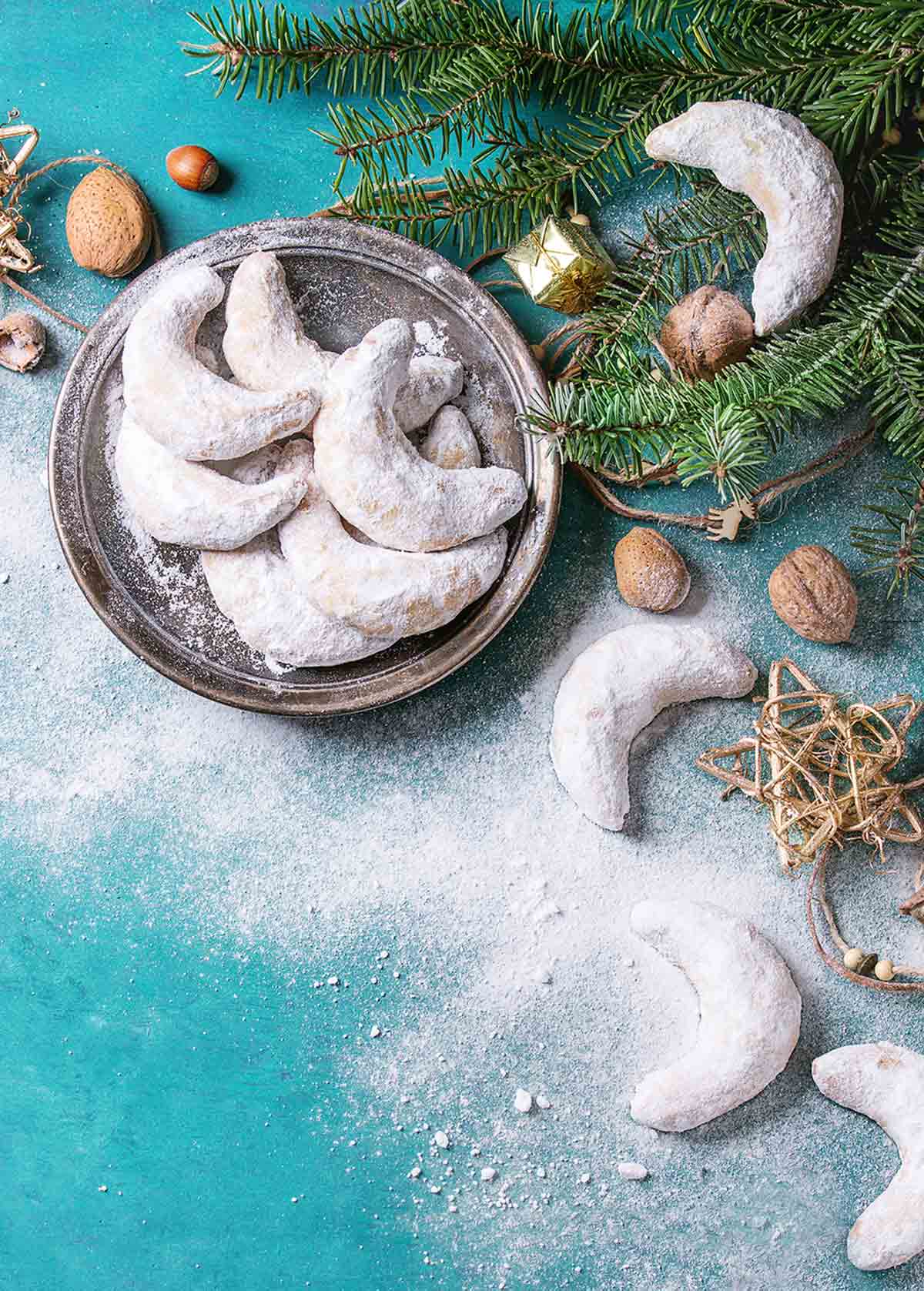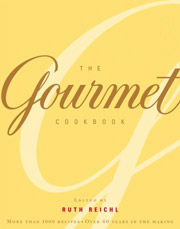Viennese crescent cookies are a tradition in Austria. They’re made with hazelnuts, shaped like a half-moon, and dusted with confectioners’ sugar. One nibble and we think you’ll understand why they’re a classic.

Adapted from Ruth Reichl | The Gourmet Cookbook | Houghton Mifflin, 2006
These Viennese crescent cookies are traditional Christmas cookies in Austria. As Gourmet magazine wrote, “From Vienna, city of music, laughter, and good food comes a cookie so delicate, so fragile, so meltingly good that it takes its place with the most famous of Vienna’s justly famous pastries.” We’re incredibly taken by these cookies, borrowed from that same issue of Gourmet, and their soulful crunch, delicate texture, and a dusting of confectioners’ sugar that’s as light as the first snowfall. We’re also more than a little curious as to their proper name. Turns out it’s Vanillekipferl, although don’t ask us how to pronounce it. Or how to say it three times fast. Especially not when we’re distracted with our mouths full of these little lovelies.–Renee Schettler
Viennese Crescent Cookies FAQs
Alice Medrich shared this nifty trick with Julia Child years ago and it’s a keeper. You blanch, or quickly dunk in boiling water, the hazelnuts. But you want to add some baking soda to the water. Use 2 cups boiling water and 3 tablespoons baking soda. Toss in the hazelnuts and boil for 3 minutes. The water may turn dark. Don’t freak out. Pour the hazelnuts and their boiling water into a colander placed in the sink and rinse under cool running water. The skins should slip right off.
If your recipe calls for toasted hazelnuts and you don’t mind a few specks of skin still stuck to the nuts, simply dump the hazelnuts on a rimmed baking sheet and toast in a 350°F (180°C) oven for about 10 minutes until the hazelnuts are pale golden and barely fragrant. Watch them closely as they can quickly go from not quite done to scorched and bitter in a matter of seconds. Immediately dump the hazelnuts onto a clean kitchen towel, fold the ends over the hazelnuts, and let them rest for about 10 minutes. Then use your hands to vigorously rub the nuts, still inside the towel, against one another. This will take off most, but not all, of the skins.
Viennese Crescent Cookies

Ingredients
For the vanilla confectioners’ sugar (for coating)
- 2 cups confectioners’ sugar
- 1 vanilla bean halved lengthwise and chopped
For the crescents
- 3 cups all-purpose flour
- 1/4 cup confectioners’ sugar
- 1/2 teaspoon salt
- 1 cup (5 oz) hazelnuts, skinned* (see "Viennese Crescent Cookies FAQs" above)
- 3 sticks (12 oz) cold unsalted butter cut into 24 pieces
Directions
Make the vanilla confectioners’ sugar
- In an airtight container, combine the confectioners' sugar and vanilla bean and let stand, covered, for at least 24 hours. Sift before using. (The vanilla sugar will keep in an airtight container at room temperature for up to several months.)
Make and bake the Viennese vanilla crescent cookies
- In a food processor or high-powered blender, pulse together the flour, 1/4 cup confectioners' sugar, salt, and hazelnuts until the nuts are finely ground, about 30 seconds. Add the butter and pulse just until a dough forms. If the dough is crumbly, you may need to pulse it a little longer until it forms a dough. Turn the dough onto your work surface and gently form it into a ball and then flatten it into a disk. Wrap it in plastic wrap or wax paper and refrigerate for at least 2 hours and up to 24 hours.
- Preheat the oven to 350°F (175°C). Adjust the oven rack to the center of the oven.
- Roll level tablespoons of dough (about 18 grams) into balls. Then roll each ball on a smooth surface into a 3-inch log with slightly tapered ends. Bend each log to form crescents and arrange them about 1 inch apart on baking sheets.
☞TESTER TIP: If you tend to have hot hands, try occasionally cupping a few ice cubes in your palm while working with the dough. It actually helps keep the butter from starting to soften, which in turn helps your cookies retain their shape.
- Bake the cookies until the edges are pale golden, 12 to 15 minutes.
- Transfer to a wire rack to cool slightly, about 2 minutes.
Coat the Viennese crescent cookies
- Sift enough vanilla confectioners' sugar onto a rimmed baking sheet to cover the bottom.
- Carefully transfer the slightly cooled baked crescent cookies to the sugared baking sheet and sprinkle with enough sugar to coat completely. Move the crescents to wire racks to cool completely. (The cookies keep, layered between sheets of wax or parchment paper, in an airtight container at room temperature for up to 5 days.)
Show Nutrition
Recipe Testers’ Reviews
These are very delicate cookies that are easy to make. They’re buttery, light, and truly “melt in your mouth.” I’ve made these before using other recipes but the vanilla sugar adds a flavor that cookies made from other recipes don’t have. They’re similar but not nearly this good.
These little Viennese vanilla crescents are the real thing. When I served them to my German friend, she said, “These bring me back to my childhood. These are just what my mother made. And they were served all over Germany and Austria and always made with hazelnuts.”
This is a dry cookie, like a shortbread. Not too sweet but with the pleasant flavor of hazelnut permeating the cookie. I found the cold dough a bit hard to work with but once I let it warm a bit, it was much easier for me to roll into a log. However, it didn’t work for me to roll it on a smooth surface, I needed to roll it between my hands.
I baked the cookies for 14 minutes, cooled them for 2 minutes, then coated them with the vanilla-infused confectioners’ sugar. The cookies moistened as they sat. After a day, they needed to have more confectioners’ sugar put on them. The taste of the hazelnuts became more pronounced as the cookies sat.
I was able to make 60 cookies.
This cookie is lovely. It has the texture of a really light shortbread. It’s incredibly crumbly and buttery. Admittedly, neither my husband nor I like hazelnuts. And this is a cookie that showcases hazelnuts beautifully. Even with our not enjoying hazelnuts, we really enjoyed these cookies. I brought them to some friends who LOVE hazelnuts, and they said that it was a beautiful butter cookie and the hazelnuts were more secondary. But they loved these cookies all the same.
I may experiment with this recipe with different nuts just for fun. Because truly, this recipe is a joy. It’s so easy to put together. They bake quickly and are simultaneously festive and rustic. They will be a star on anyone’s holiday cookie plate!
So light and toothsome and refreshingly blended with vanilla and nutty flavors. These cookies were delightful and quick to eat but a bit time-consuming to prepare. My son helped me coat the warm cookies in vanilla sugar. They were so good right then and then again in the morning with coffee and then again for an afternoon coffee!
The preparation had to be planned out in stages because the vanilla sugar, skinned hazelnuts, and the prepared dough all took additional hours to prep. I ended up refrigerating the dough for the full 24 hours. I used a scale to weigh each 18-gram ball and didn’t bother with leveling out a tablespoon of dough. I did have ice cubes on hand because my kitchen was warm but I didn’t find that I needed them.
These are a delicious, nutty cookie that isn’t too sweet. The dough comes together quite quickly. Most of the time will be spent rolling out the dough to make the crescents.
I don’t have a food processor so had to dirty my blender and stand mixer to make the cookies. In the blender, it took about 30 seconds (it’s a Vitamix) to grind the nuts with the flour and sugar. I tried adding the butter to the blender but that didn’t work so I dumped the entire mixture into my stand mixer. It took about 4 to 5 minutes of mixing for a dough to form and for the butter to be evenly distributed. It’s quite a soft and supple dough. I chilled the dough for 2 hours.
For me, it was easier to roll the dough in my hands instead of on a surface, My counter ended up getting quite buttery and slippery. My cookies baked for about 14 minutes. I think they were slightly larger than the 18g recommended. The cookies have now been in a tin for a few days and will need a powdered sugar refresh before they get served. I would make this recipe again but might just bake them in rounds instead of crescents.
The flavor of these cookies is great. Rolling the crescents is not that easy but they look really pretty. These made a wonderful gift. Also, if you don’t want to roll the crescents, you can press them down to between 1/4- to 1/2-inch thickness and bake them as circles. These also turned out well.
These cookies are really delicious. They are delicate, melt-in-your-mouth, not too sweet, and the nuts add a slight texture that is very pleasing. I really like the flavor and texture of these.
It was very time-consuming to get each crescent very consistent. They looked good but these are definitely a “rough” look cookie unless you spend a lot of time shaping. The shaping of these cookies went over my time expectations for cookie-making, so I probably wouldn’t make these again as the recipe states. I realized after tasting them that my Nana made a very similar cookie that was shaped into a ball and called “snowballs.”
The vanilla confectioners’ sugar was good, but I’m not sure it made a huge difference in flavor. Nevertheless, I didn’t mind making it, and I like having the extra on hand to dust other holiday treats and sweet breads.
I had the best luck, and the cookies looked the most consistent, when I used a bench scraper to cut the dough into a long strip, then cut the strip into 2 1/2- to 3-inch pieces that I would shape. That was a little quicker, too. I like to get the cookies into a relatively consistent shape and with the method on the recipe, I was frustrated because they looked too different (even with weighing each ball of dough). If I made these again, I would probably shape them into balls, or even roll them into thick discs. However, I assume the shape is important to the origin or tradition of the cookie.
I baked the first batch for 13 minutes until the edges were lightly golden. The cookies were so delicate, however, that I baked the second batch for 15 minutes—not a huge difference in color but they were a little sturdier. After cooling completely, both batches were sturdy enough to move easily. But when warm, they were very delicate.
The cookies kept really well. The sugar was pretty much intact after a day. At 2 days, the change was hardly discernible. At 3 days, I would give the cookies a fresh sprinkle of the sifted vanilla confectioners’ sugar if I were serving guests, but there was still some sugar visible on them. There was really no flavor or texture change after 3 days, so they keep very well.
Originally published October 1, 2006


